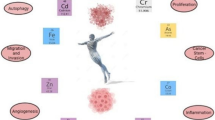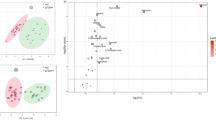Abstract
Determination of copper in human tissues and body fluids may be crucial in the diagnosis of Wilson’s disease. In this study we evaluated urinary copper excretion and urine and blood concentration in 14 patients in whom Wilson’s disease was confirmed (group A) and in 21 subjects in whom the disease was only suspected (group B). The following values (mean ± SD) were found: 24-h urine (μg Cu/24 h), 152 ± 135 (A) and 31.8 ± 10.9 (B); urine (μg Cu/ml), 0.091 ± 0.087 (A) and 0.028 ± 0.011 (B); and blood (μg Cu/ml), 0.62 ± 0.25 (A) and 0.72 ± 0.09 (B). By comparison, urine copper concentration in the group of apparently healthy subjects was 0.035 ± 0.010 (n = 50), and blood copper concentration in autopsy cases of nonpoisoned people was 0.85 ± 0.19 (n = 73).

Similar content being viewed by others
References
Loudianos G, Gitlin JD (2000) Wilson’s disease. Semin Liver Dis 20:252–364
Langner C, Denk H (2004) Wilson disease. Virchows Arch 445:111–118
Tankanov RM (1991) Pathophysiology and treatment of Wilson’s disease. Clin Pharm 10:839–849
Gitlin JD (2003) Wilson disease. Gastroenterology 125:1868–1877
Asseth J, Morseth T (1986) Copper. In: Friberg L, Nordberg GF, Vouk VB (eds) Handbook on the toxicology of metals, vol. 2. Elsevier, Amsterdam, pp 233–254
Yuce A, Kocak N, Demir H, Gurakan F, Ozen H, Saltik IN, Ozcay F (2003) Evaluation of diagnostic parameters of Wilson’s disease in childhood. Indian J Gastroenterol 22:4–6
Vanderwerf SM, Cooper MJ, Stetsenko IV, Lutsenko S (2001) Copper specifically regulates intracellular phosphorylation of the Wilson’s disease protein, a human copper-transporting ATPase. J Biol Chem 276:36289–36294
Roberts EA, Schilsky MLA (2003) A practice guideline on Wilson disease. Hepatology 37:1475–1492
Stremmel W (1996) Aktuelle Diagnostik: hereditare Stoffwechselerkrangungen der Leber (primare Hëmochromatose, Morbus Wilson). Schweiz Rundsch Med Prax 85:1513–1517
Cauza E, Maier-Dobersberger T, Polli C, Kaserer K, Kramer L, Ferenci P (1997) Screening for Wilson’s disease in patients with liver diseases by serum ceruloplasmin. J Hepatol 27:358–362
Smolarek C, Stremmel W (1999) Therapy der Morbus Wilson. Z Gastroenterol 37:293–300
Rath HG, Enger IM, Ruschoff J, Schmolmerich J, Holstege A (1997) Akute hämolytische Krise als Erstmanifestation eines Morbus Wilson. Z Gastroenterol 35:199–203
Keller R, Torta R, Lagget M, Crasto S, Bergamasco B (1999) Psychiatric symptoms as late onset of Wilson’s disease: neurological findings, clinical features and treatment. Ital J Neurol Sci 20:49–54
Iyengar GV, Kollmer WE, Bowen HJM (1978) The elemental composition of human tissues and body fluids. A compilation of values for adults. Verlag Chemie, Weinheim
Plenert W, Heine W (1978) Normalwerte. VEB Verlag Volk und Gesundheit, Berlin
Haswell SJ (ed) (1991) Atomic absorption spectrometry. Theory, design and applications. Elsevier, Amsterdam, pp 368–370
Hamilton EI, Sabbioni E, Van der Venne MT (1994) Element reference values in tissues from inhabitants of the European Community. VI. Review of elements in blood, plasma and urine and a critical evaluation of reference values for the United Kingdom population. Sci Total Environ 158:165–190
Lech T, Hydzik P (2007) Significance of copper determination in late onset of Wilson’s disease. Clin Toxicol (in press)
Tietz NW (ed) (1995) Clinical guide to laboratory tests. W. B. Sanders Company, Philadelphia, pp 168–169
Piekoszewski W, Pach J, Sadlik K, Winnik L (2000) Changes in serum copper level during detoxification of acutely poisoned drug addicts. Biol Trace Elem Res 78:1–6
Barany E, Bergdahl IA, Bratteby LE, Lundh T, Samuelson G, Schutz A, Skerfing S, Oskarsson A (2002) Trace element levels in whole blood and serum from Swedish adolescents. Sci Total Environ 286:129–141
Acknowledgments
The authors would like to thank Dr. Joanna Furgał, Dr. Monika Rudzińska, and other neurologists from Department of Neurology, Collegium Medicum, Jagiellonian University, Kraków, Poland, for providing blood and urine samples for copper determinations.
Author information
Authors and Affiliations
Corresponding author
Rights and permissions
About this article
Cite this article
Lech, T., Sadlik, J.K. Contribution to the Data on Copper Concentration in Blood and Urine in Patients with Wilson’s Disease and in Normal Subjects. Biol Trace Elem Res 118, 16–20 (2007). https://doi.org/10.1007/s12011-007-0015-y
Received:
Accepted:
Published:
Issue Date:
DOI: https://doi.org/10.1007/s12011-007-0015-y




